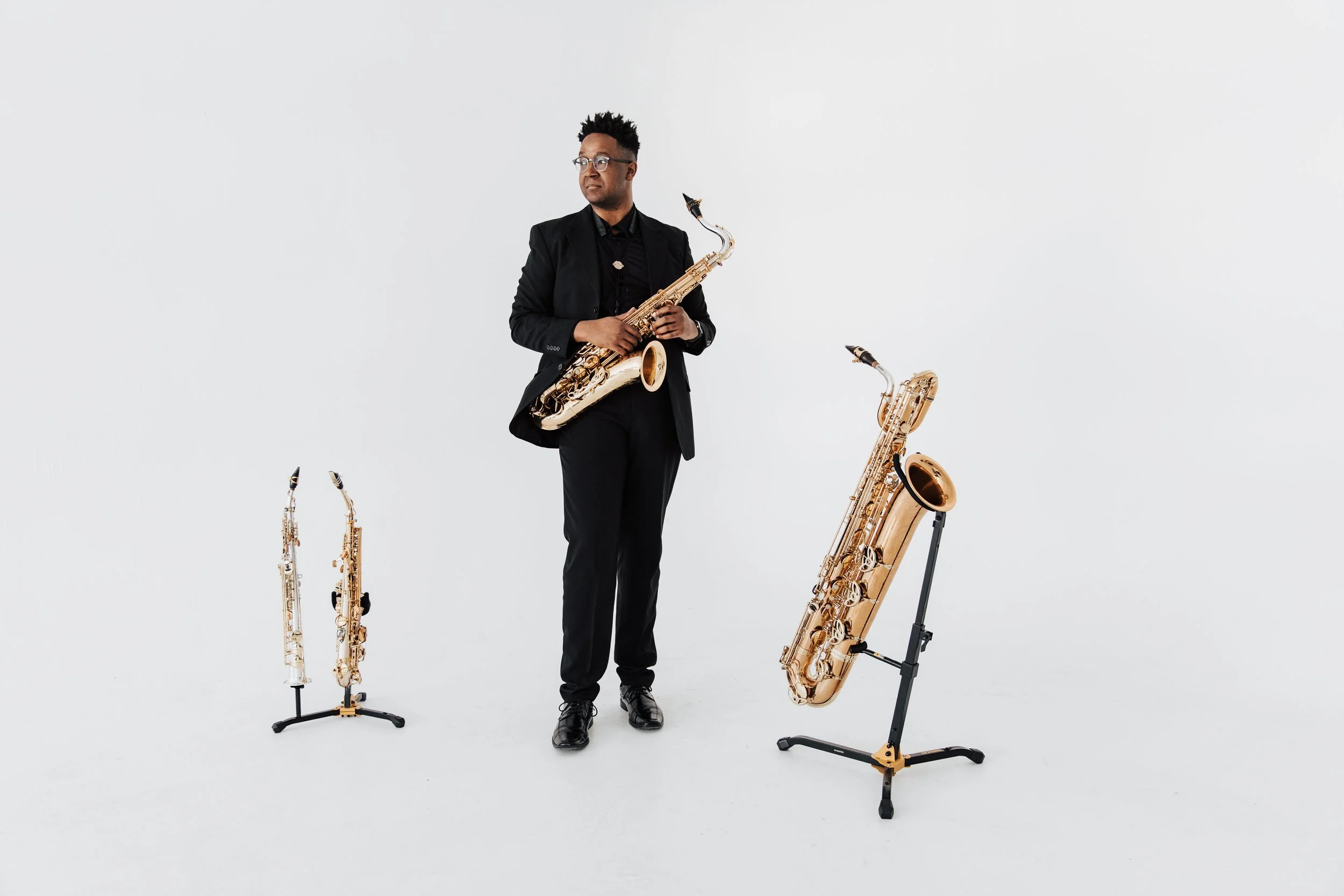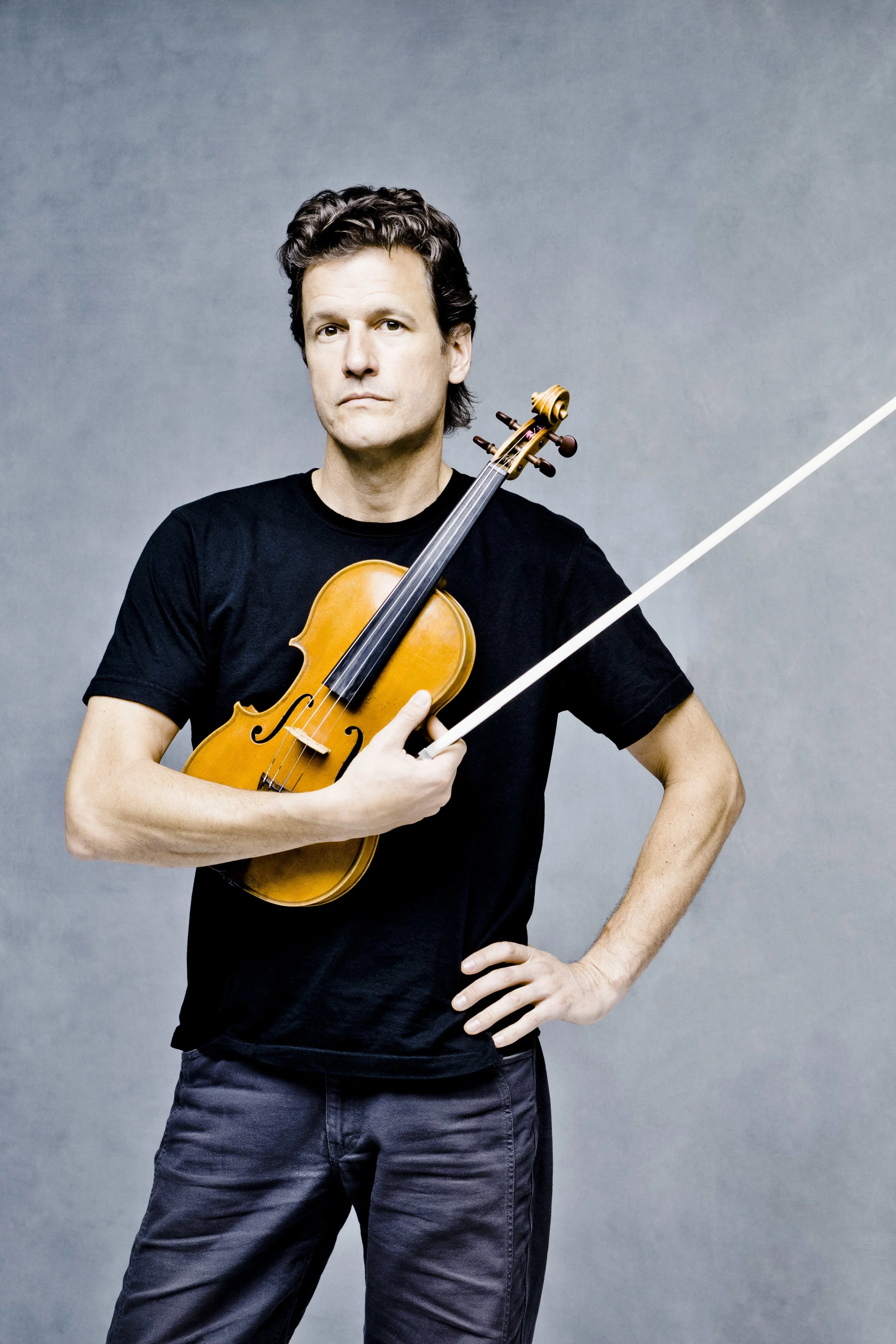PC: Angela Orellana
Come what may for tenor saxophone and string quartet
When I started writing Come What May, my goal was to explore timelessness in music. What I realized during the composition process is that, for many reasons, the act of honest creation cannot include consideration of what the masses may or may not do with a work after it has been created.
There is no formula one can follow to ensure the creation of a “timeless” piece of art. What is inherently timeless, however, is our humanity. The small, yet infinite sliver of consciousness that we each carry allows us all to have a singular experience of the world and unique set of proclivities. As such, the job of a composer must be to express their individual voice in the truest possible way and to follow their curiosities and inclinations where they lead.
Right now, I am very much fascinated by composers like Brahms, who were able to make such grand musical statements with such small amounts of thematic material. The primary theme of Come What May, presented in the tenor saxophone at the beginning of the piece, came to me after a meditation session I did with my instrument in hand. After allowing the silence of the room to become predominant, and allowing my mind to become quiet, the first melody that emerged through my instrument was this one.
The writing process gave me the opportunity to develop a relationship with this theme by stylizing, transposing, compressing, and displacing it in so many ways that felt relevant and meaningful. Just as we are all challenged by the various trials of life, the themes of Come What May are challenged in many ways, but hopefully emerge stronger at the end with a clearer sense of identity and purpose than could have been reached without the journey.
Duration: ~16’
Reflections and exaltations for soprano saxophone and string quartet
"Often, when struggling against obstacles of every sort which oppose my labors: often, when the powers of mind and body weakened, and it was difficult to continue the course I had entered on; — a secret voice whispered to me: 'there are so few happy and contented peoples here below; grief and sorrow are always their lot; perhaps your labors will once be a source from which the care-worn, or the man burdened with affairs, can derive a few moments of rest and refreshment.' This was indeed a powerful motive to press onwards, and this is why I now look back with cheerful satisfaction on the labors expended on this art, to which I have devoted so many long years of uninterrupted effort and exertion."
-Franz Joseph Haydn
In the very brief period of time that I knew him, Geoff Nuttall reinvigorated my love of music and exposed me to new dimensions of its ability to unite, thrill, challenge, and inspire. There have only been a handful of people, concepts, and experiences which have made such a fundamental shift to my outlook on my role as a musician in society. The process of composing Reflections and Exaltations gave me the opportunity to honor Geoff in my own way and meditate on these various illuminative learnings.
Invocation, the first movement, depicts a fantastical, inward journey that I went on as I looked for guidance as to how I could best honor the life of someone so uniquely special and important to me. The work starts with a prayer or invitation for an ancestor to join me on the way. The ancestor in this case is my maternal grandfather, who always served as a “north star” and role model for the person I aspire to be. Once his spirit appears, the journey has three major destinations, each with its own lesson to teach. The three destinations are akin to the musical “altars” of Johannes Brahms, Maurice Ravel, and Alexander Scriabin. These are three composers who I often feel the presence of when I compose. After visiting these destinations, there is a dialogue with my travel partner in which we attempt to make sense of what we have seen along the way. After some over-efforting and fretful rumination, we come to the understanding that there is no one right message to glean, and that I have to find my own unique path using the wisdom that I have been exposed to. My grandfather eventually fades back into his resting place, leaving me with both the terror and comfort of this reality.
The second movement, Quinten, is a celebration of individuality. During the Spoleto USA Festival of 2022, I remember Geoff excitedly showing me a musical idea in the first movement of Franz Joseph Haydn’s String Quartet, Op. 76, No. 2, which is commonly referred to as the Quinten quartet. This motive includes four dramatic swells, repeated one after the other in a very short period of time. We connected over just how strange and ahead-of-its-time this particular motive was. Haydn is well-known to have said “I was cut off from the world. There was no one to confuse or torment me, and I was forced to become original.” This idea also connects deeply with advice that has stuck with me from two of my other greatest mentors, pianist André Watts, and jazz musician and teacher David Baker. André once told me “you don’t have to search for your musical voice; you have to find the courage to let it out.” David used to always say “that’s nice, but put your own thing on it” to inspire me to be more unique and imaginative. Geoff Nuttall certainly had the courage to let out his individual musical voice as a performer and music director, and it connected with people in an infectious way. I tried to let my musical mind lead me wherever it naturally wanted to go in this movement without censoring or over-thinking.
My intention in writing the Meditation movement was to give the audience and performers a chance to reflect on the ultimate reality of the universe - interconnectedness. Geoff was so skilled at bringing people together through music, and I wanted to provide a moment for people to close their eyes and experience the power and magic of a collective moment of awareness in the concert hall. To do this, the string quartet invites the audience to focus on their breath by creating sounds of inhalation and exhalation, and compositional techniques inspired by medieval chant and the music of Arvo Pärt hopefully bring forth a moment of timelessness.
It is no secret that Geoff’s favorite composer was Franz Joseph Haydn. In writing the Finale movement, I was listening to Haydn non-stop. Geoff spent much of his life as an evangelist for Haydn’s music, so I wanted to take in as much as I could in his honor. As Geoff was so full of life and love, I wanted to create a moment of joyous celebration that would perhaps leave us all with a smile. Towards the end of the movement, there is a final reflective moment, full of plagal cadences (also known as the “Amen” cadence) and a hopeful lyricism that represents us watching Geoff’s soul finally ascend to the heavens.
Reflections and Exaltations was commissioned by the St. Lawrence Quartet and Persis Drell & James Welch in memory of Geoff Nuttall.
Duration: ~30’
Begin Again for Baritone saxophone, cello, piano, and Meditation guide
At the start of his time with the Artist Propulsion Lab, composer and saxophonist Steven Banks set out to compose a piece of music that explores meditation and mindfulness, and in which the music and meditation were supportive partners. The result is Begin Again, created in collaboration with Ten Percent Happier meditation teacher Matthew Hepburn. Begin Again uses guided meditative exploration and musical composition to lend insight into the ways that we relate to struggles within ourselves and in the world. On the final episode of this year's Artist Propulsion Lab, Steven and Matthew take us inside Begin Again, followed by a performance of the entire piece.
Duration: ~45’
Cries, Sighs, and Dreams for alto Saxophone and String Quartet
For Cries, Sighs, and Dreams, composer and saxophonist Steven Banks found inspiration in the history of the saxophone. When Adolphe Sax first arrived in Paris in summer 1842, he invited composer Hector Berlioz to inspect a prototype of his new instrument. Berlioz was impressed, writing, “It cries, sighs, and dreams. It possesses a crescendo and can gradually diminish its sound until it is only an echo of an echo of an echo—until its sound becomes crepuscular.” A few years later, he repeated his praise of the instrument, writing in Le Journal des débats, “I know of no other instrument that possesses this particular capacity to reach the outer limits of audible sound.”
Written between late 2020 and early 2021 (an expansion and transformation of an earlier work for the same ensemble), the piece was born out of Banks’s experience of the isolation of pandemic lockdowns: teaching saxophone lessons on Zoom, the lack of performance opportunities, the end of a relationship. “I just felt completely lost,” he recalls. But gradually, he came to terms with his inner and outer chaos, accepting it, even if he wasn’t necessarily happy about it.
This piece takes his pandemic experience and generalizes it to depict transitions more broadly. It is divided into three broad sections which roughly map onto the moods of the three words from the Berlioz quote in the title. “Cries” is full of discordant, tumultuous harmonies and sharper sounds in the strings. “Sighs” is more nebulous and oblique, drawing on the woozy harmonies of late Scriabin. And “Dreams” is like a saxophone aria. Interspersed between these sections are improvised passages where the saxophonist (here, the composer) creates a moaning sound that even more directly reflects these various emotional states.
Program note written by Dan Ruccia.
Duration: ~14’
Headphones highly recommended. Piece begins VERY quietly and is intended to start in darkness.
Jacob’s StairCAse for Reed Quintet
Jacob's Staircase takes a light-hearted, perhaps even comical, appoach to the feeling of a never-ending climb. This piece draws musical inspiration from two very different works that depict never-ending ascents: the spiritual We Are Climbing Jacob's Ladder and Ligeti's infamous thirteenth piano etude, The Devil's Staircase.
The lyrics to We Are Climbing Jacob's Ladder, like most spirituals, are relatively simple and Biblical on the surface. However, many believe that they referred to the seemingly endless journey to freedom for the enslaved Black Americans who would have sung this song while working.
Ligeti's The Devil's Staircase is one of my favorite works for piano. Its chromaticism and cyclical nature are reminiscent of a climb to nowhere or a journey that continually brings you back to its beginning. The contrasting middle section of this work can be thought of as a meditative reflection on one's journey towards the ultimate goal.
-Steven
Jacob’s Staircase was commissioned by the Yale Bands, Yale Glee Club, and Yale Symphony Orchestra.
Duration: ~3’




